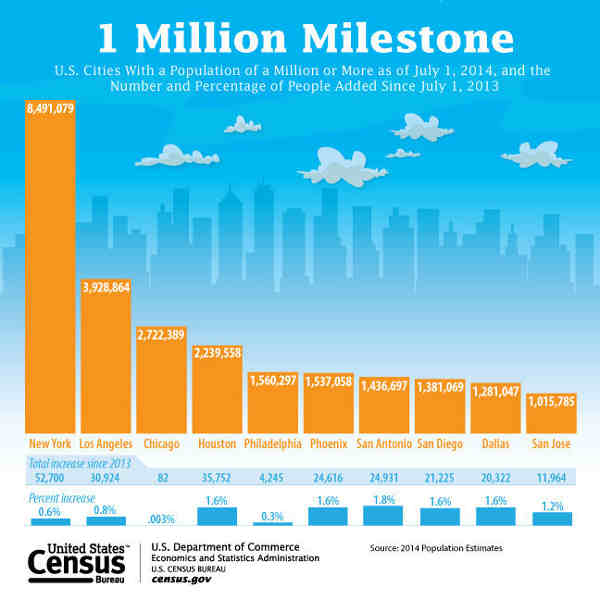Ten U.S. Cities Have 1 Million People or More

San Jose, Calif., is now among the 10 U.S. cities with a population of 1 million or more, according to estimates released Thursday by the U.S. Census Bureau.
California now has three cities with 1 million or more people (Los Angeles, San Diego and San Jose), tying Texas (Houston, San Antonio and Dallas) for the lead among states.
New York remained the nation’s most populous city and gained 52,700 people during the year ending July 1, 2014, which is more than any other U.S. city.
Half of the 10 cities with the largest population gains between 2013 and 2014 were in Texas — Houston, Austin, San Antonio, Dallas and Fort Worth. Each added more than 18,000 people.
[ Is New Delhi the Dirtiest City of the World? ]
The Lone Star State also had six of the top 13 fastest-growing cities by percentage — San Marcos, Georgetown, Frisco, Conroe, McKinney and New Braunfels.
San Marcos, situated between Austin and San Antonio, was the fastest-growing city for the third consecutive year, with its population climbing 7.9 percent between 2013 and 2014 to reach 58,892.
The West was home to eight cities among the top 15 fastest-growing cities with a population of 50,000 or more. Four were in California. Each of the 15 fastest-growing cities between 2013 and 2014 were in the South or West, as were all but two of top 15 numerical gainers.
[ U.S. Population to Reach 400 Million in 2051 ]
The lone exception, aside from New York, was Columbus, Ohio, which gained 12,421 people over the period to make it the nation’s 13th largest numerical gainer. Ohio’s capital was the nation’s 15th most populous city in 2014, with 835,957 residents.
The only change in the rank order of the 15 most populous cities between 2013 and 2014 was Jacksonville, Fla., and San Francisco, each moving up one spot to 12th and 13th place, respectively, passing Indianapolis, which fell from 12th to 14th.
The statistics released Thursday cover all local governmental units, including incorporated places (like cities and towns), minor civil divisions (such as townships) and consolidated cities (government units for which the functions of an incorporated place and its parent county have merged).
You can get more information about the geographic areas for which the Census Bureau produces population estimates.
The population clock, one of the most visited features of the Census Bureau website census.gov, displays continuously updated projections of the U.S. population, including the rate of births, deaths and net migration for the United States.
The projections are based on a monthly time series of population estimates starting with the April 1, 2010, resident population count derived from the 2010 Census.






